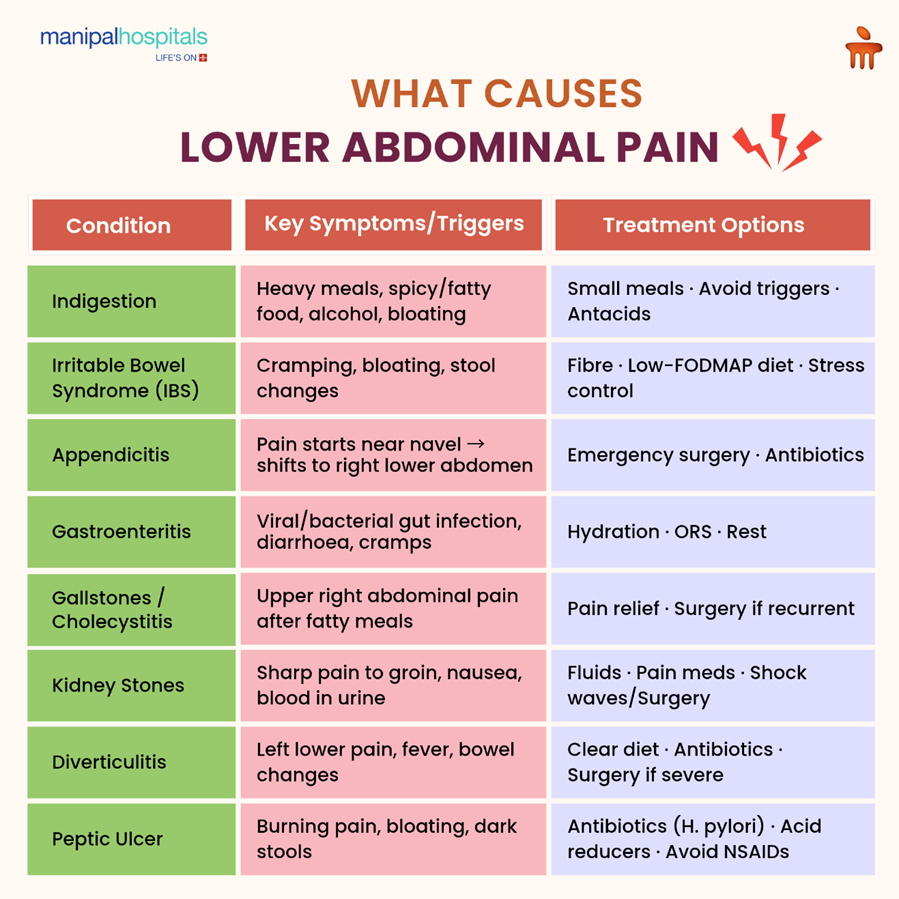Abdominal pain is one of the most frequent reasons people visit a hospital. Depending on the condition, it can range from mild discomfort after meals to severe pain requiring urgent care. There are many causes, and they can include infections, inflammation, stones, or functional disorders. While some cases of lower abdominal pain resolve with simple measures, others indicate serious disease needing prompt treatment. Understanding the common triggers helps patients recognise when to seek help. This blog looks at 10 widespread conditions that affect both men and women. Each condition will be explained with causes, symptoms, and the role of tests in finding the underlying reasons for lower abdominal pain.
What is Lower Abdominal Pain?
Lower abdominal pain refers to discomfort felt below the belly button. It can range from a dull ache to sharp cramps and may be constant or come and go. Both men and women experience it, and the causes vary widely, from indigestion and infections to stones or inflammatory conditions. Sometimes the pain is harmless and short-lived, but in other cases, it signals a serious condition that needs urgent medical care. Knowing the common reasons for lower abdominal pain helps you understand when simple remedies are enough and when to see a doctor.
Lower abdominal pain is sometimes accompanied by other symptoms like bloating, nausea, changes in bowel habits, urinary symptoms, fever, and sometimes pain that radiates to the back or pelvis. Serious symptoms like severe pain, blood in stool, or persistent vomiting require urgent medical attention.
Lower Abdominal Pain: Causes and Treatment
The following are the key reasons for lower abdominal pain:

1. Indigestion
Indigestion is discomfort or burning felt in the upper abdomen, often after meals. It may come with bloating, nausea, or belching. Common triggers include large meals, fatty or spicy food, coffee, alcohol, and some medicines such as NSAIDs. Stress and infection with Helicobacter pylori are also recognised causes.
Treatment options:
-
Smaller, regular meals.
-
Avoid food or drinks that trigger symptoms.
-
Limit alcohol and stop smoking.
-
Antacids or acid-reducing drugs, when prescribed.
2. Irritable Bowel Syndrome (IBS)
Irritable Bowel Syndrome is a functional disorder of the large intestine and is one of the major causes of lower abdominal pain. It leads to abdominal cramping, bloating, and altered stool pattern. Some patients have constipation, others diarrhoea, or a mix of both.
The bowel looks normal on tests, but symptoms persist. Triggers include certain foods, stress, and abnormal gut movement. Diagnosis is made after ruling out infections, celiac disease, or inflammatory bowel disease.
Treatment options:
-
Add dietary fibre when constipation is present.
-
Restrict high-FODMAP foods if symptoms worsen.
-
Use antispasmodics or antidiarrheal drugs when required.
-
Address stress with exercise or relaxation therapy.
3. Appendicitis
Appendicitis is inflammation of the appendix. It follows blockage, which is often caused by hard stool, lymphoid swelling, or, less commonly, a tumour. Infection develops, and pus collects. Pain typically begins around the navel, then localises to the right lower abdomen. Loss of appetite, nausea, vomiting, and mild fever are common. Delay in treatment risks rupture and peritonitis. Diagnosis is based on clinical signs, blood tests showing raised white cells, and imaging with ultrasound or CT.
Treatment options:
-
Immediate appendectomy.
-
Intravenous antibiotics before surgery.
-
Laparoscopic or open removal, depending on findings.
4. Gastroenteritis
Gastroenteritis is an infection of the stomach and intestines. It is usually caused by viruses such as norovirus or rotavirus, but bacteria like E. coli or Salmonella can also be responsible. The main symptoms are watery diarrhoea, stomach cramps, nausea, and sometimes fever. Dehydration is the most serious risk, especially in young children and older adults. The illness is often short, lasting a few days, but severe cases need medical care.
Treatment options:
-
Drink plenty of fluids with salts and sugars.
-
Oral rehydration solution if diarrhoea is frequent.
-
Rest and light meals until recovery.
-
Antibiotics are only used when a bacterial cause is confirmed.
5. Gallstones/ Cholecystitis
The gallbladder is an organ that stores bile for digestion. Gallstones are hard deposits that form in the gallbladder. The block can stop the flow of bile and cause sudden pain in the upper right abdomen, often after fatty meals. If the gallbladder becomes swollen and infected, the condition is called cholecystitis. Symptoms include steady abdominal pain, nausea, vomiting, and sometimes fever. Untreated, it can lead to complications like infection spreading or gallbladder damage.
Treatment options:
-
Pain relief and antibiotics if infection is present.
-
Fasting and IV fluids in hospital care.
-
Surgery to remove the gallbladder if attacks repeat or complications develop.
6. Kidney Stones
Kidney stones are solid crystals that form inside the kidney. Small ones may pass without symptoms. Larger stones block urine flow and trigger sudden pain. The pain can spread from the back into the groin and is one of the common causes of lower abdominal pain.
Other signs include nausea, vomiting, or blood in the urine. Diagnosis is made with urine tests and scans, such as a CT or an ultrasound.
Treatment options:
-
Increase fluid intake to help pass small stones.
-
Pain medicines for relief.
-
Drugs that relax the urinary tract in selected cases.
-
Shock waves or surgery if the stones are large or stuck.
7. Diverticulitis
Diverticulitis occurs when small pouches in the wall of the colon become inflamed or infected. It is seen more often in older adults. The pain is steady and felt low on the left side, a typical reason for lower left side abdominal pain. Fever, nausea, and a change in bowel movements may occur. Doctors confirm it with an examination and a CT scan.
Treatment options:
-
Simple diet changes with clear fluids in mild cases.
-
Antibiotics are used when an infection is present.
-
Pain control with prescribed medicines.
-
Surgery if episodes are repeated or if complications set in.
8. Peptic Ulcer Disease
Peptic ulcers are open sores in the lining of the stomach or upper small intestine. They are usually caused by infection with Helicobacter pylori or long-term use of painkillers like aspirin and NSAIDs. Burning pain in the upper abdomen is the main symptom, but some patients also report bloating, nausea, or dark stools from bleeding. In a few cases, pain can be mistaken for other causes of lower abdominal pain. Diagnosis is made with endoscopy and tests for H. pylori.
Treatment options:
-
Antibiotics to clear H. pylori infection.
-
Acid-reducing drugs such as proton pump inhibitors.
-
Avoid NSAIDs and smoking.
-
Surgery only if ulcers bleed or perforate.
Conclusion
Lower abdominal pain can signal many different conditions, from simple indigestion to infections or stone disease. Some problems settle with diet changes or medicines, while others need urgent care. Recognising the source early helps prevent complications. If you have persistent or severe lower abdominal pain, consult a specialist without delay.
For timely diagnosis and expert management, book a consultation at Manipal Hospital Bhubaneswar. Experienced doctors and advanced diagnostic facilities are available to guide you with accurate care and treatment.
FAQ's
Doctors may recommend patients to undergo blood tests, urine tests, an ultrasound, or a CT scan. Endoscopy or colonoscopy is done if stomach or bowel disease is suspected.
Yes. Stress and anxiety can affect gut movement and sensitivity, leading to cramps or bloating. However, persistent pain should not be ignored without medical evaluation.
If you have sudden, severe pain with fever, vomiting blood, black stools, or inability to pass urine or stool, you may need urgent care at a hospital set up.
Outside of the conditions covered, other important causes include bowel obstruction, Crohn’s disease, ulcerative colitis, abdominal aortic aneurysm, and pelvic inflammatory disease. Each requires prompt assessment.
Yes. High-fat, spicy, or sugary foods may trigger indigestion or reflux. A diet lacking fibre may worsen constipation-related pain. Balanced meals with enough fluids reduce strain on the digestive tract.





















 7 Min Read
7 Min Read


9.png)



7.png)
.png)
6.png)




